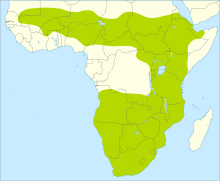| Secretarybird | |
|---|---|

| |
| in the Maasai Mara | |
| Scientific classification | |
| Domain: | Eukaryota |
| Kingdom: | Animalia |
| Phylum: | Chordata |
| Class: | Aves |
| Order: | Accipitriformes |
| Family: | Sagittariidae |
| Genus: | Sagittarius Hermann, 1783 |
| Species: | S. serpentarius
|
| Binomial name | |
| Sagittarius serpentarius (J. F. Miller, 1779)
| |

| |
| Distribution shown in green | |
| Synonyms[2] | |
|
List
| |
The secretarybird or secretary bird (Sagittarius serpentarius) is a large bird of prey that is endemic to Africa. It is mostly terrestrial, spending most of its time on the ground, and is usually found in the open grasslands and savanna of the sub-Saharan region. John Frederick Miller described the species in 1779. A member of the order Accipitriformes, which also includes many other diurnal birds of prey such as eagles, hawks, kites, vultures, and harriers, it is placed in its own family, Sagittariidae.
The secretarybird is instantly recognizable as a very large bird with an eagle-like body on crane-like legs that give the bird a height of as much as 1.3 m (4 ft 3 in). The sexes are similar in appearance. Adults have a featherless red-orange face and predominantly grey plumage, with a flattened dark crest and black flight feathers and thighs.
Breeding can take place at any time of year but tends to be late in the dry season. The nest is built at the top of a thorny tree, and a clutch of one to three eggs is laid. In years with plentiful food all three young can survive to fledging. The secretarybird hunts and catches prey on the ground, often stomping on victims to kill them. Insects and small vertebrates make up its diet.
Although the secretarybird resides over a large range, the results of localised surveys suggest that the total population is experiencing a rapid decline, probably as a result of habitat destruction. The species is therefore classed as Endangered by the International Union for Conservation of Nature. The secretarybird appears on the coats of arms of Sudan and South Africa.
- ^ BirdLife International (2020). "Sagittarius serpentarius". IUCN Red List of Threatened Species. 2020: e.T22696221A173647556. doi:10.2305/IUCN.UK.2020-3.RLTS.T22696221A173647556.en. Retrieved 19 November 2021.
- ^ Sharpe, Richard Bowdler (1874). Catalogue of the Birds in the British Museum. Vol. 1. London: British Museum (Natural History). Department of Zoology. p. 45.
